Mysteries of pristine Kimberley wilderness are being unravelled at last
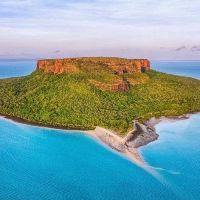
The natural mysteries of the Kimberley, one of Australia’s last pristine habitats, have been documented like never before thanks to a multi-million-dollar project.

The natural mysteries of the Kimberley, one of Australia’s last pristine habitats, have been documented like never before thanks to a multi-million-dollar project.
The natural mysteries of the Kimberley, one of Australia’s last pristine habitats, have been documented like never before thanks to a multi-million-dollar project.
One Ten East Logs from the IIOE-2 voyage aboard RV Investigator will be posted on the WAMSI website during the month long voyage.
Today we are at Station 17. We are slowly creeping north with our studies and the pygmy blue whales are calling us northward too! – Captain Micheline Jenner
Log from One Ten East
The RV Investigator is currently undertaking oceanographic research along the 110°E meridian off Western Australia as part of the second International Indian Ocean Expedition. The voyage is led by Professor Lynnath Beckley of Murdoch University and the research is supported by a grant of sea time on RV Investigator from the CSIRO Marine National Facility.
| Date: June 03, 2019 | Time: 1200 AWST |
| Latitude: 14°S | Longitude: 110°E |
| Wind direction: ESE | Wind speed: 17 knots |
| Swell direction: ENE 2m, ESE 2m | Depth: 5715 m |
| Air temperature: 27°C | Sea temperature: 28°C |
Notes: Two crested terns flew around the ship today. With few seabird sightings in the last week, their fluttering was encouraging and welcome!
Isotopes in Food Web Studies
By Michael Landry
Direct measurements of phytoplankton growth and grazing by micro- and mesozooplankton are one way to look at variability in trophic structure in our study region (e.g., how many steps are mesozooplankton removed on average from phytoplankton). Analyses of bulk nitrogen and carbon isotopes from the size-fractioned mesozooplankton net tows will also provide an independent check on these estimates. Trophic information from isotopes comes from the fact that the lighter and more abundant isotope of nitrogen (14N) is selectively utilized by organisms when they metabolize, so the remaining proteins in animal tissues get enriched in the heavier isotope 15N. There’s a saying for this, “You are what you eat plus 3.4 parts per thousand 15N”, which captures the notion that this particular relationship has been widely applied in food web studies of both aquatic and land systems.
An additional important goal of our study is to use isotopes to determine how the food web may have changed over the five decades since the first International Indian Ocean Expedition (IIOE). This cannot be done by standard bulk isotope method which would require separate sampling for phytoplankton isotopes which vary substantially depending on whether the main source of N to the food web is nitrate mixed upward from deep water or fixed N2 gas from the atmosphere (or some combination). Instead, we will use a relatively new technique called Compound-Specific Isotopic Composition of Amino Acids (CSIA-AA), which relies on differences in isotopic enrichment of individual amino acids to provide information. A group of source AAs retains 15N enrichment values similar to the baseline value of N. Another group of trophic AAs enriches very strongly with each trophic transfer step. The fact that N isotopic composition doesn’t change much with long-term preservation in formalin means we can use historical IIOE samples collected at the same stations and same time of year in the 1960s to compare N sources and trophic structure for the same dominant species sorted from the samples.
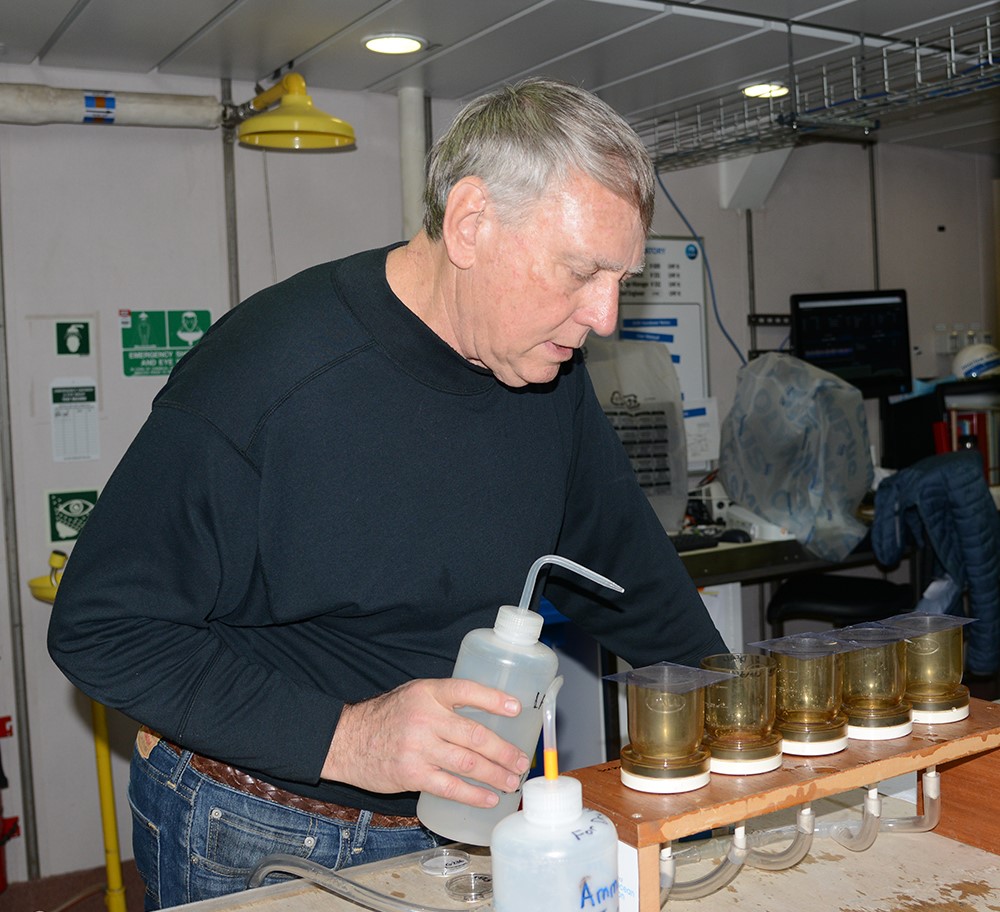
Prof Michael Landry (Scripps Institution of Oceanography, USA) filters the size-fractionated mesozooplankton collected in the oblique plankton net tow. Photo: Micheline Jenner AM.
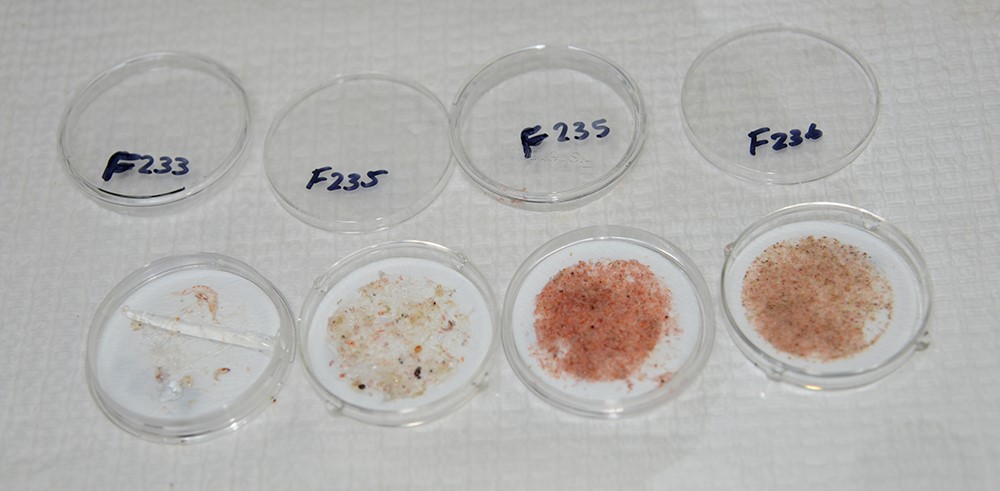
The size-fractionated mesozooplankton are filtered onto glass filter paper for further processing to assess isotopes. Photo: Micheline Jenner AM.
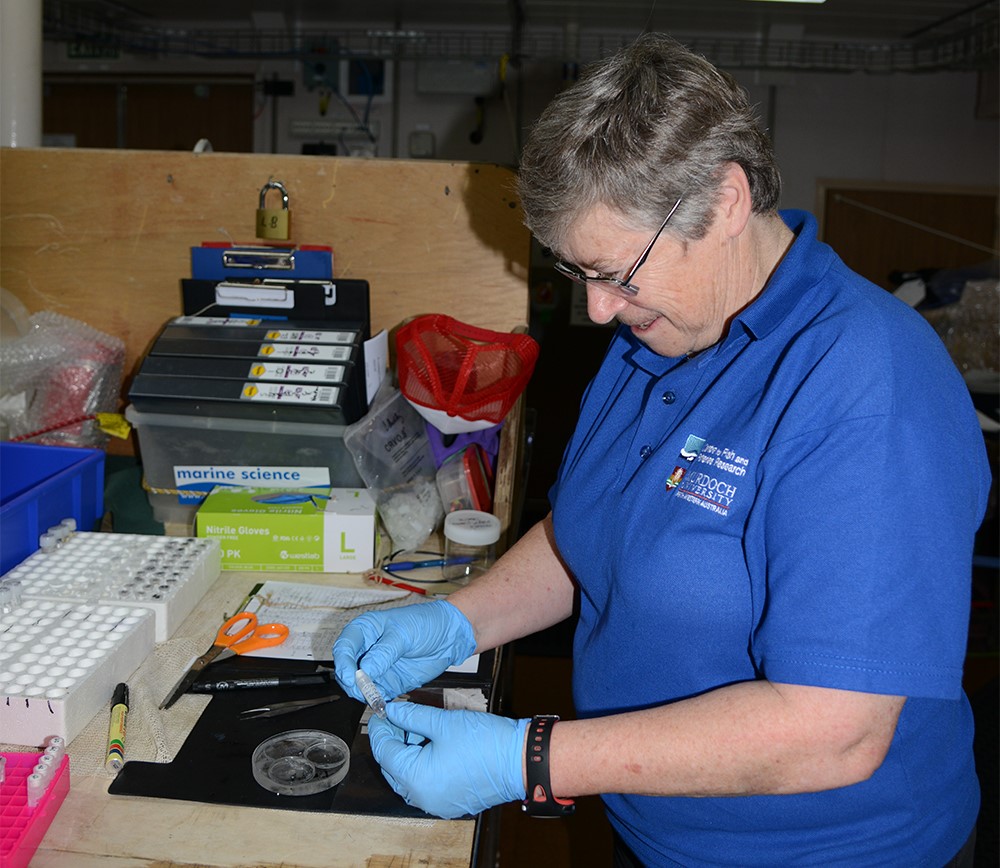
Prof. Lynnath Beckley (Chief Scientist, Murdoch University) labels a zooplankton sample for isotope analysis for the study with Prof Michael Landry (Scripps Institution of Oceanography, USA) examining isotopes in oceanic food webs. Photo: Micheline Jenner AM.
3
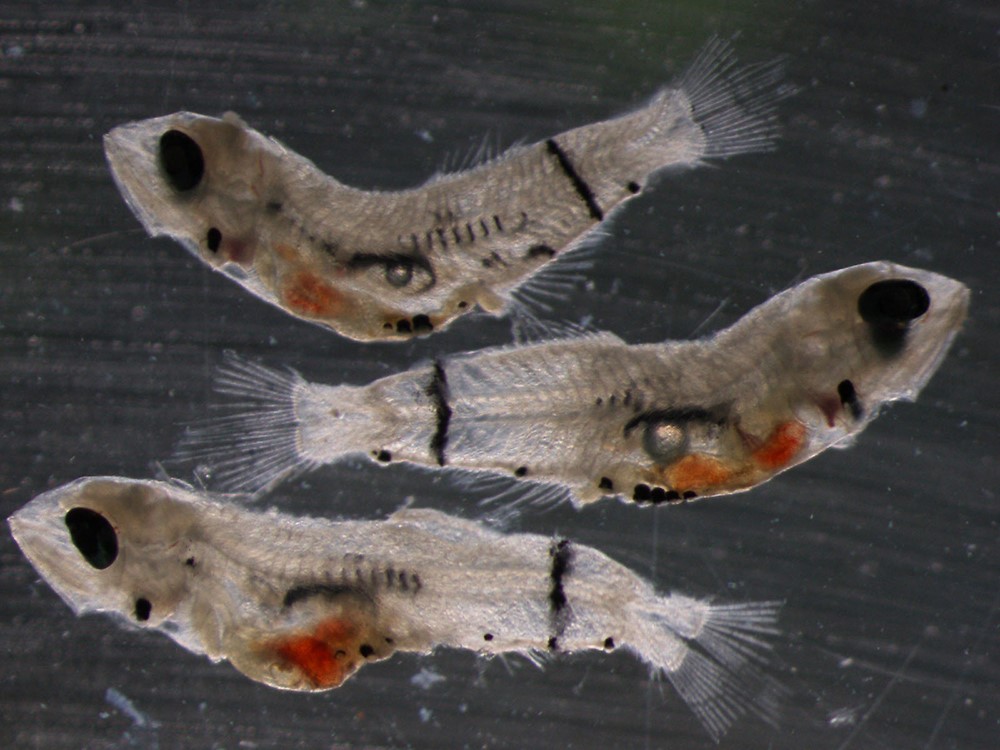
Freshly caught Margrethia sp. larval fish with their stomachs full of copepods (shown as red and orange) inside their transparent bodies. It’s not always so easy to see what fish have eaten! Photo: Dr Pilar Olivar (CSIC, Barcelona).
One Ten East Logs from the IIOE-2 voyage aboard RV Investigator will be posted on the WAMSI website during the month long voyage.
Today’s rousing trade winds were for perfect sailing across the Indian Ocean pond! If we hang up all the sheets, we’ll be there shortly Kiran and Satya!
What day of the week is it? Ocean life blurs this… every day is blue!
– Captain Micheline Jenner
Log from One Ten East
The RV Investigator is currently undertaking oceanographic research along the 110°E meridian off Western Australia as part of the second International Indian Ocean Expedition. The voyage is led by Professor Lynnath Beckley of Murdoch University and the research is supported by a grant of sea time on RV Investigator from the CSIRO Marine National Facility.
| Date: June 02, 2019 | Time: 1200 AWST |
| Latitude: 15.5°S | Longitude: 110°E |
| Wind direction: E | Wind speed: 17 knots |
| Swell direction: SE 2m, NE 0.5m, SW 2m | Depth: 5727 m |
| Air temperature: 27°C | Sea temperature: 27°C |
Notes: At Station 17 of 20 on the 110°East line, we are in some of the deepest water so far.
Ocean Food Webs
By Prof Michael Landry
Food webs describe the feeding (trophic) relationships that exist among organisms in an ecosystem. If you have heard the old fisherman’s adage that “big bait catches big fish”, you may intuitively understand how ocean food webs operate, mainly on the basis of size, with larger consumers eating successively smaller prey down to where it all begins with microscopic phytoplankton. This is fundamentally different than food webs on land, where the plants are often much larger than their consumers (e.g., insects grazing on trees).
A further twist of ocean food webs is that different ocean conditions select for different sizes of phytoplankton. In the poorest (oligotrophic) environments, which occur over much of the tropical and subtropical open ocean, very small phytoplankton (photosynthetic bacteria) dominate because they are the most efficient competitors for nutrient uptake at low concentrations. In nutrient-rich coastal systems, large phytoplankton are dominant. One consequence of this difference is that open-ocean food webs lose most of their energy in transfers from tiny producers to tiny consumers on up, with little remaining in the end to support fisheries. In contrast, richer systems with large phytoplankton and larger consumers have fewer steps of intermediate consumers and can channel productivity more efficiently to fishes.
In this project (IN2019_V03), we are taking two approaches to compare food-web relationships along the stations and regions on the cruise track. One is experimental, involving measurements of community composition, productivity and grazing rates. The other utilizes information that resides in the isotopic composition of planktonic consumers to quantify their mean trophic positions in the food web relative to phytoplankton.
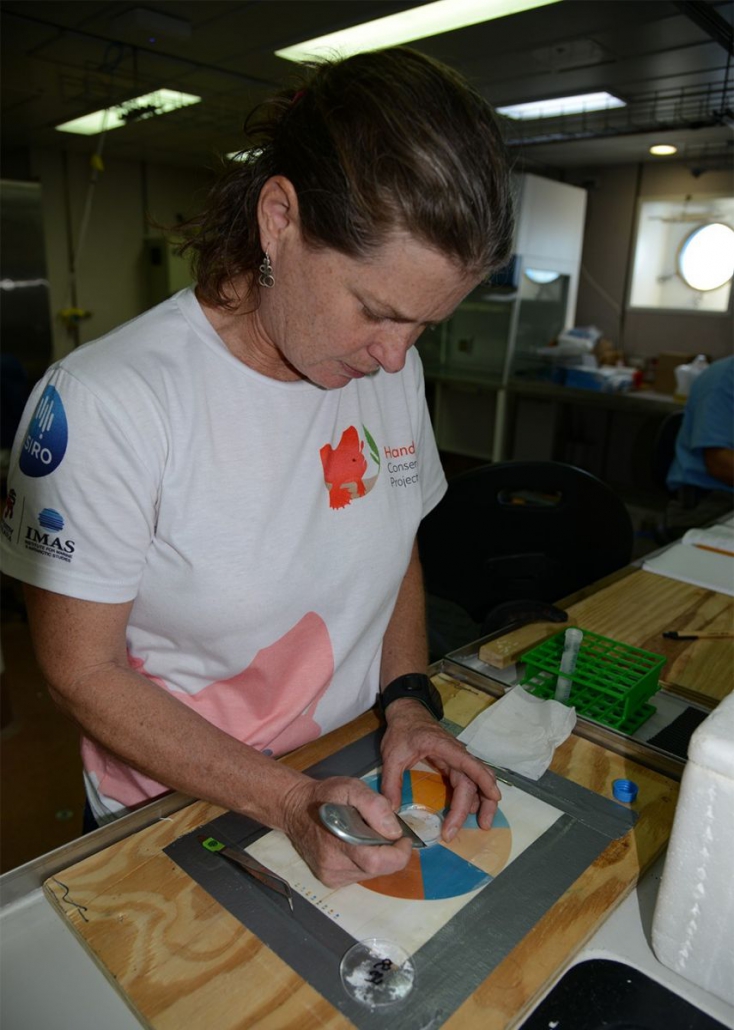
Claire Davies (IMOS/CSIRO) halves one of the filtered zooplankton samples for sonification and fluorometric analysis to ascertain grazing by copepods. Photo: Micheline Jenner AM.
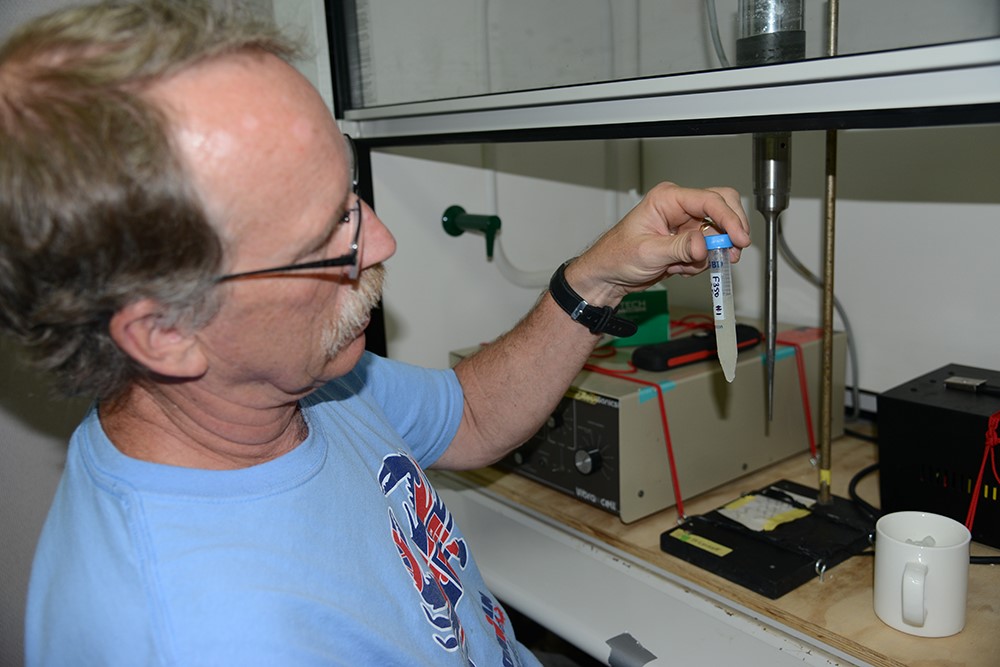
Prof Raleigh Hood (University of Maryland Center for Environmental Science) shows the copepod material which was macerated with the sonicator (a low frequency sound emitted from the metal spike, in backgorund) prior to determination of the chlorophyll content. Photo: Micheline Jenner AM.
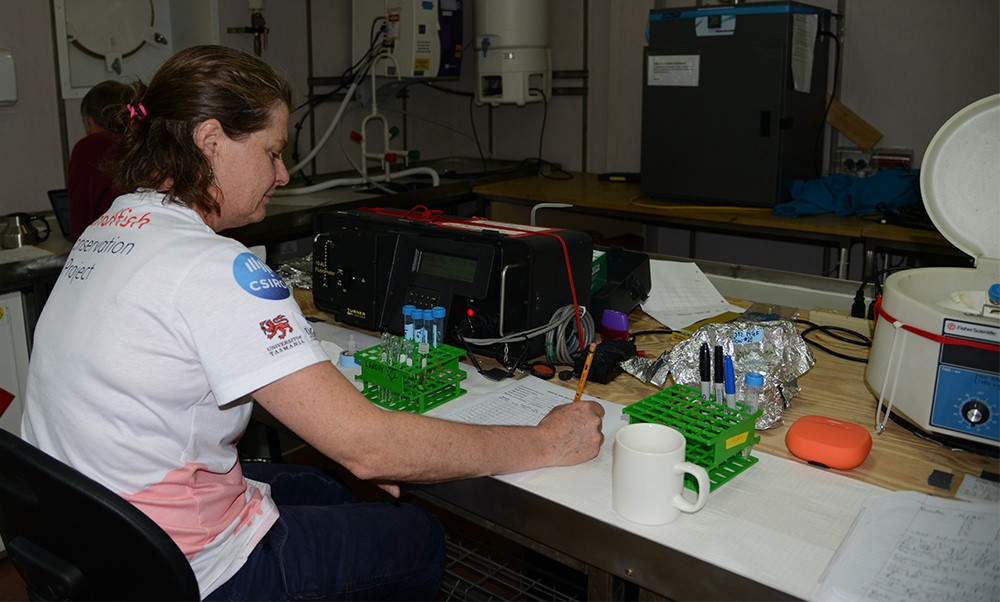
Claire Davies (IMOS/CSIRO) measures the chlorophyll content with the fluorometer to determine the extent of grazing on phytoplankton by copepods in the mesozooplankton samples collected with the oblique plankton tow. Photo: Micheline Jenner AM.
One Ten East Logs from the IIOE-2 voyage aboard RV Investigator will be posted on the WAMSI website during the month long voyage.
The sun is shining, the nets are being pulled in and out and life is good aboard RV Investigator. – Captain Micheline Jenner
Log from One Ten East
The RV Investigator is currently undertaking oceanographic research along the 110°E meridian off Western Australia as part of the second International Indian Ocean Expedition. The voyage is led by Professor Lynnath Beckley of Murdoch University and the research is supported by a grant of sea time on RV Investigator from the CSIRO Marine National Facility.
| Date: June 01, 2019 | Time: 1200 AWST |
| Latitude: 17°S | Longitude: 110°E |
| Wind direction: ESE | Wind speed: 25 knots |
| Swell direction: SE 2 m | Depth: 5634 m |
| Air temperature: 27°C | Sea temperature: 27°C |
Notes: Cooling breezy trade winds and white caps on the ocean today!
Primary Production
By David Antoine
Every year in the contemporary ocean, phytoplankton use energy from the sun to take up carbon, nutrients and trace elements, and to transform it into a staggering amount of about 50 billion tons of organic matter. This is referred to as the oceanic net primary production (NPP), and is equivalent to the annual production of terrestrial plant ecosystems. NPP is commonly expressed in grams of carbon fixed per unit time and ocean surface area, e.g., a daily production in grams of Carbon per square metre. Oceanic NPP is thus a major component of the global carbon cycle, because part of the carbon taken up by phytoplankton is balanced by a flux of carbon dioxide (CO2) from the atmosphere to the ocean. This, combined with the transfer of organic matter (carbon) towards the deep ocean, make up what is referred to as the oceanic biological pump of carbon.
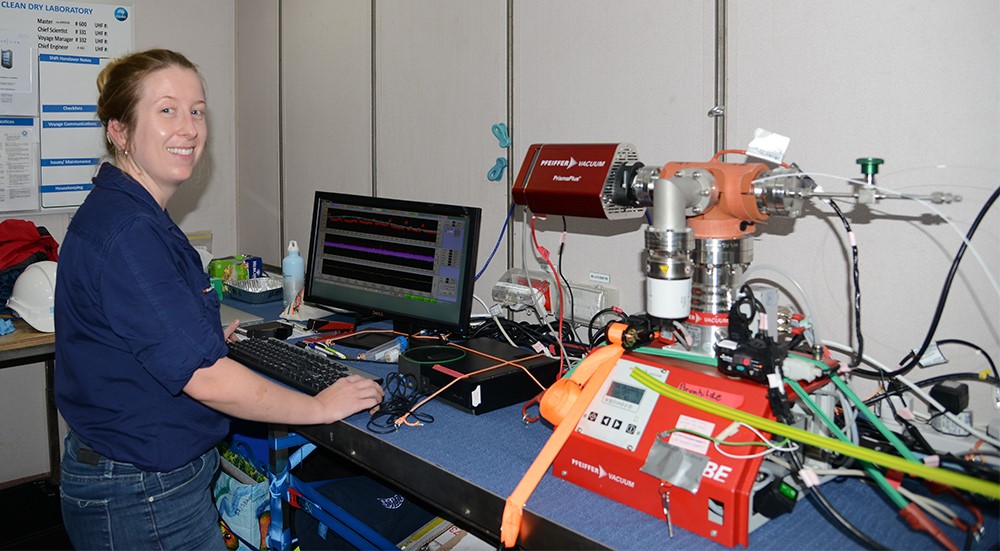
Dr Charlotte Robinson (Curtin University) uses an AC-S spectrophotometer to determine primary production in the continuous flow-through seawater from a sub-surface intake on the RV Investigator. Photo: Micheline Jenner AM.
On the RV Investigator voyage primary production of phytoplankton from different depths of the ocean is being measured using incubations with radioactive Carbon14 in a photosynthetron. These estimates of primary production will be compared with those determined during the first International Indian Ocean Expedition 60 years ago.
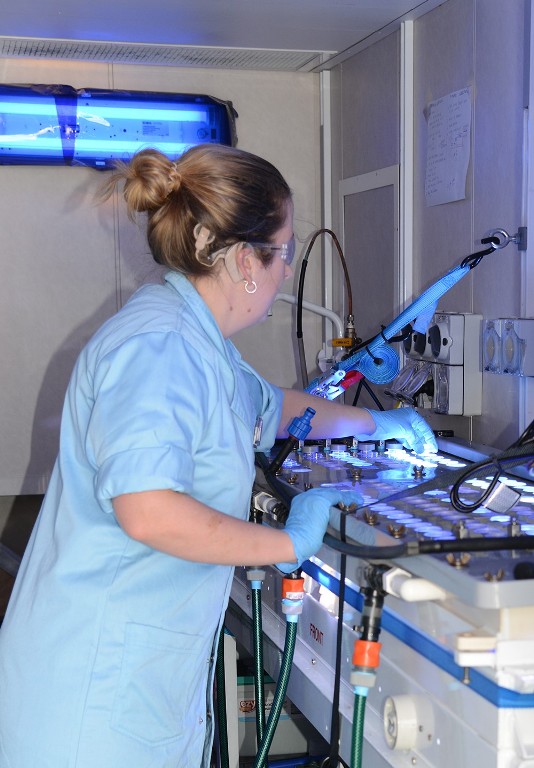
Dr Charlotte Robinson (Curtin University) in the modular Isotope Container aboard the RV Investigator, conducting primary production studies with the photosynthetron at different light levels. Photo: Micheline Jenner AM.
Be sure to follow the daily posts of our One Ten East Logs from the IN2019_V03 aboard RV Investigator at https://iioe-2.incois.gov.in and www.wamsi.org.au.
One Ten East Logs from the IIOE-2 voyage aboard RV Investigator will be posted on the WAMSI website during the month long voyage.
Curt and I were listening to an Antarctic minke whale for most of the morning and sure enough it came past the vessel. These are often curious whales, so we were optimistically expectant, that the loud caller might come by. A crew member on deck spied it and alerted us! Alas, we had had our heads in a spreadsheet to share our data. It was a fleeting but lovely visit, enough to confirm the caller we heard was indeed an Antarctic minke whale, yeah! – Captain Micheline Jenner
Log from One Ten East
The RV Investigator is currently undertaking oceanographic research along the 110°E meridian off Western Australia as part of the second International Indian Ocean Expedition. The voyage is led by Professor Lynnath Beckley of Murdoch University and the research is supported by a grant of sea time on RV Investigator from the CSIRO Marine National Facility.
| Date: May 31, 2019 | Time: 1200 AWST |
| Latitude: 18.5°S | Longitude: 110°E |
| Wind direction: E | Wind speed: 16 knots |
| Swell direction: ESE 1.5 m | Depth: 4981 m |
| Air temperature: 26°C | Sea temperature: 27°C |
Notes: Another tropical day with cumulus clouds and the deep blue sea.
Cytometry in the Micro-CSI Lab
By Martina Doblin
The Microbial Cell Sorting and Imaging or Micro-CSI is a mobile laboratory belonging to the University of Technology Sydney (UTS) is being used on board RV Investigator. On this voyage, the Micro-CSI houses a state-of-the-art flow cytometer, which uses laser light to analyse living cells and sort them from other particles in seawater. Cells (ranging in size from 0.5 to 50 microns) can be sorted and counted based on characteristics such as their relative size, internal complexity and fluorescence properties, varying upon the identity and physiological status of each cell. Cells of the same species will share common attributes such as the number and type of cellular membranes, organelles and pigments and are therefore visualised as cells that cluster tightly in the graphical output.
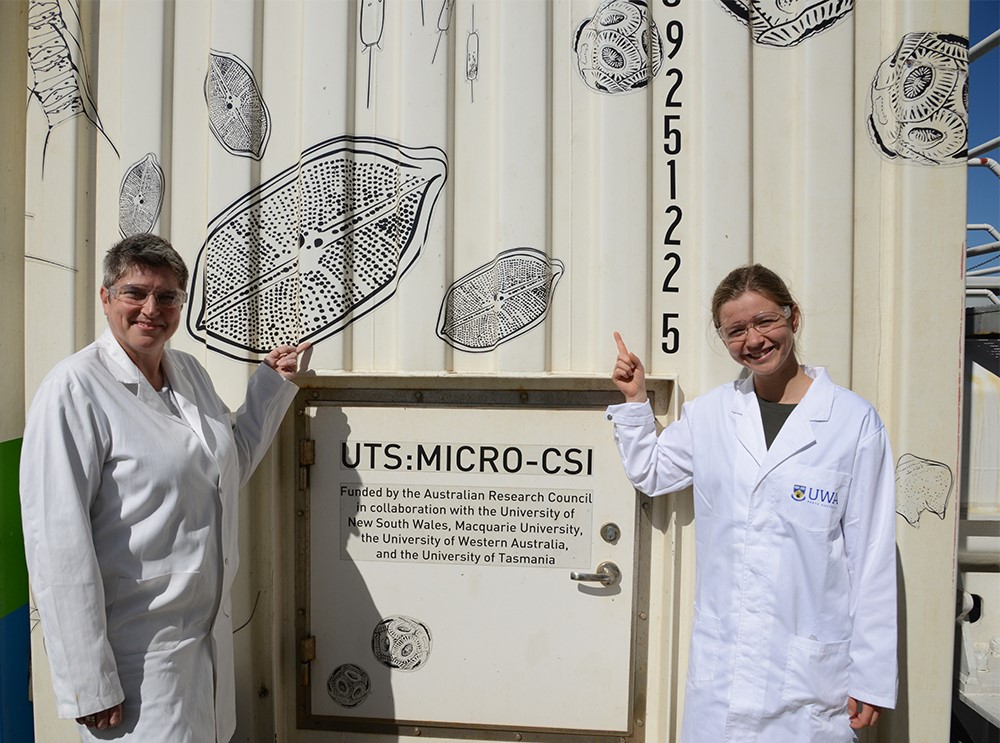
Peta Vine (PhD student University of Technology Sydney) at left and Camille Grimaldi (PhD student University of Western Australia) at right, stand outside the Micro-CSI mobile laboratory that has been loaded aboard the RV Investigator. Photo: Micheline Jenner AM.
Using the flow cytometer, we are determining the distribution of phytoplankton populations collected at various locations along the 1100 East transect. We are also isolating cells capable of photosynthesis (those containing pigments such as chlorophyll) and preserving them for future on-shore analysis. This information will be used to help estimate the primary productivity of marine phytoplankton, which represents the potential for nutrients and energy to be transferred to upper levels of the food web.
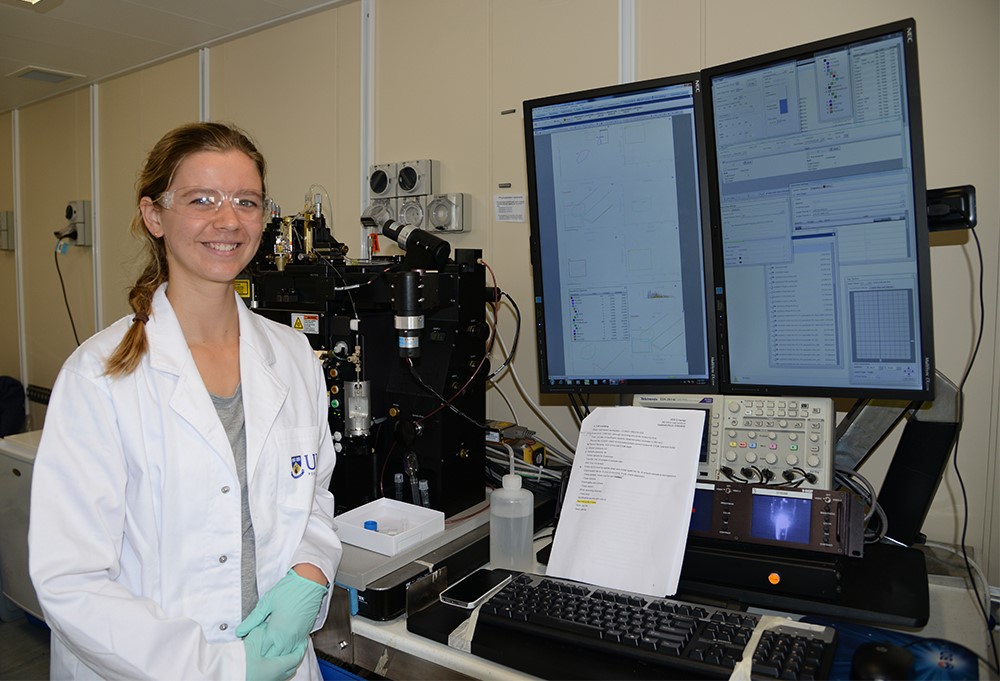
Inside the Micro-CSI laboratory, Camille Grimaldi (PhD student UWA) operates the state-of-the-art BD-Influx cell sorter. A water sample from the CTD is placed in a glass tube, and is analysed using lasers to provide detailed information regarding phytoplankton distribution and abundance along the 110°East meridian. Photo: Micheline Jenner AM.
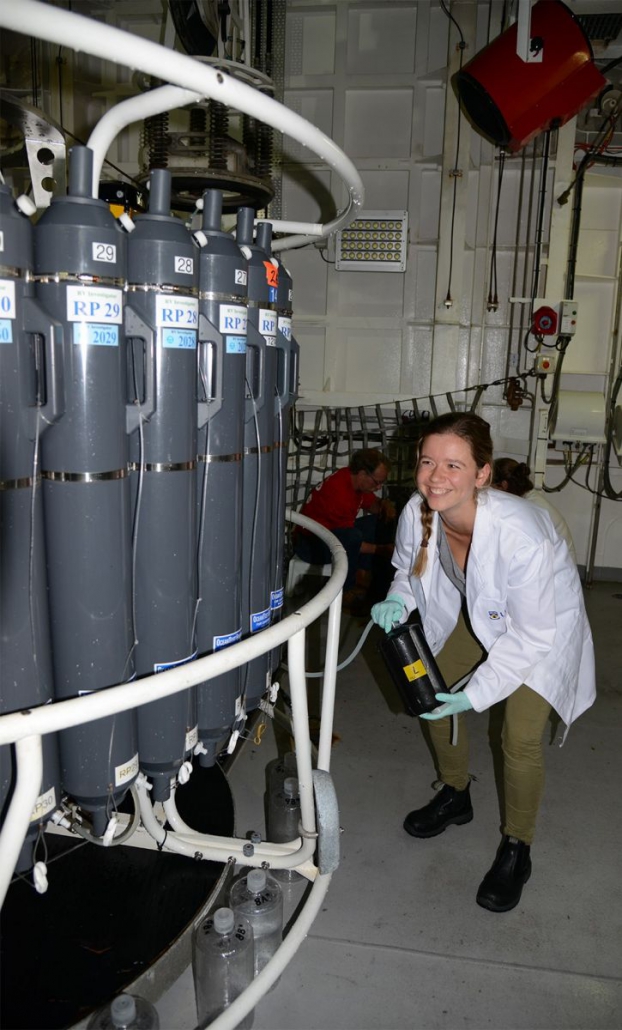
Camille Grimaldi (PhD student University of Western Australia) collects water from the CTD that is analysed using the flow-cytometer in the Micro-CSI laboratory. Photo: Micheline Jenner AM.
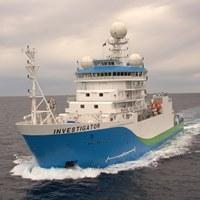
One Ten East Logs from the IIOE-2 voyage aboard RV Investigator will be posted on the WAMSI website during the month long voyage.
Another wonderful day had aboard RV Investigator with stunning calm conditions across the day and an amazing sunset.
– Captain Micheline Jenner
Log from One Ten East
The RV Investigator is currently undertaking oceanographic research along the 110°E meridian off Western Australia as part of the second International Indian Ocean Expedition. The voyage is led by Professor Lynnath Beckley of Murdoch University and the research is supported by a grant of sea time on RV Investigator from the CSIRO Marine National Facility.
|
Date: May 29, 2019 |
Time: 1200 AWST |
|
Latitude: 21.5°S |
Longitude: 110°E |
|
Wind direction: SE |
Wind speed: 10 knots |
|
Swell direction: S 1 m |
Depth: 5070 m |
|
Air temperature: 25°C |
Sea temperature: 25°C |
|
Notes: Beautiful sunny weather, warm seas and lots of tropical flying fish. |
|
Dilution Experiments
By Michael Landry
Phytoplankton can go through one or two generations (cell divisions) per day and are often eaten almost as fast as they divide, by protozoan grazers.
Because the size ranges of phytoplankton and microzooplankton broadly overlap, they cannot be mechanically separated from one another to determine these two different rates.
We do, however, have a technique for this, which involves dilution of the grazing impact. This entails changing the encounter frequency of predators and prey using filtered water with the same chemistry, from the same depth.
We create two conditions–one with natural concentrations of predators and prey and the other in which the grazing has been slowed by about 2/3rds. From the differences in the measured rates of increase of phytoplankton of the two treatments, we can solve the equations for the two unknown rates.
We run our experiments in a seawater-cooled, shipboard incubator system that has 6 light levels simulating the conditions of underwater light at the six depths where we collected our samples from the CTD.
The change in phytoplankton concentration in each bottle is measured by chlorophyll and by flow cytometry analyses of dominant populations.
After a lot of filtering, analyses and calculations, we will have a pretty good idea of how much of phytoplankton productivity is consumed by microzooplankton each day, how that varies with depth in the euphotic zone, and if there are significant differences among the stations or regions that we are sampling along the 110°East line.
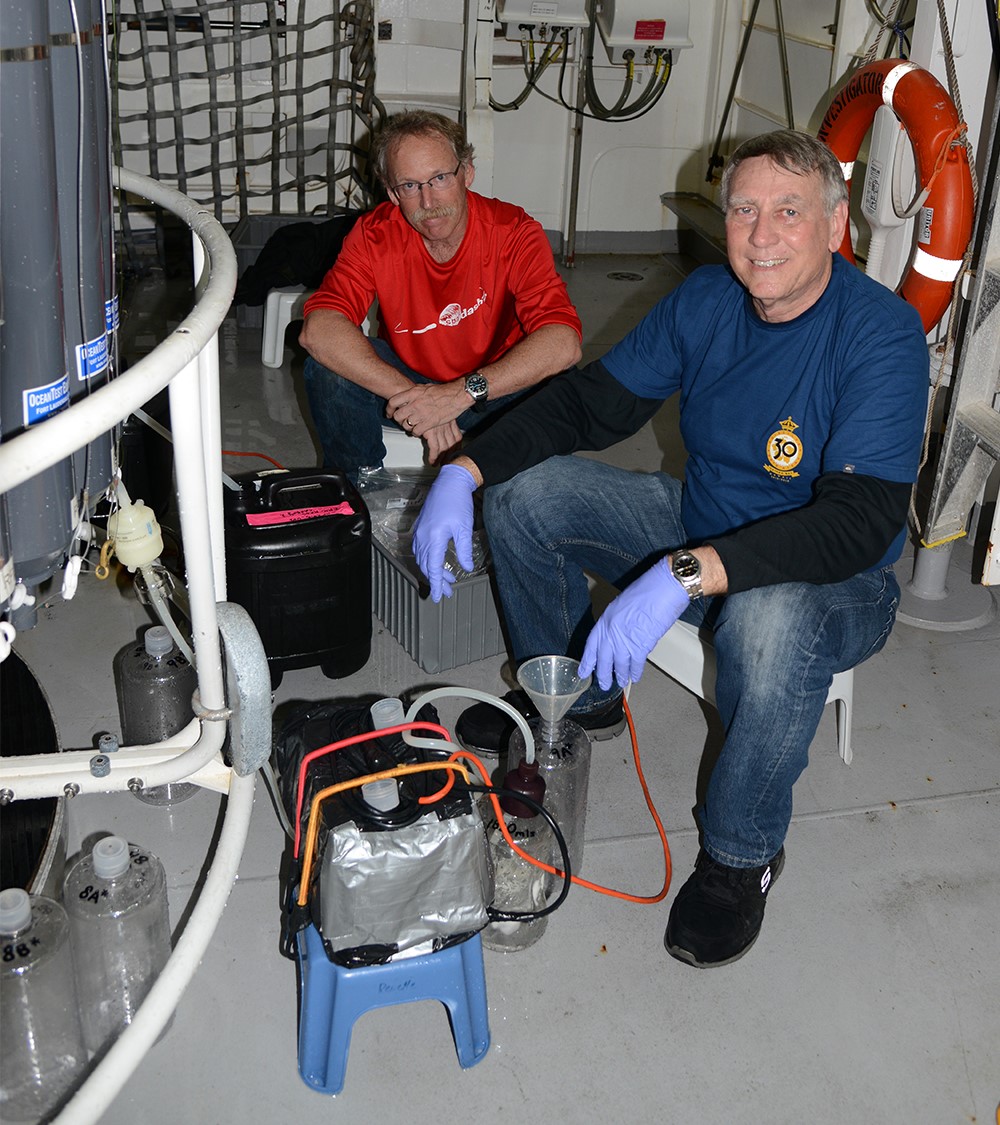 |
|
Prof Michael Landry (Scripps Institution of Oceanography, USA) and Prof Raleigh Hood (University of Maryland Center for Environmental Science) filtering water from the CTD in preparation for Prof Landry’s world-renowned dilution experiments, which are conducted on the aft deck of RV Investigator. Photo: Micheline Jenner AM. |
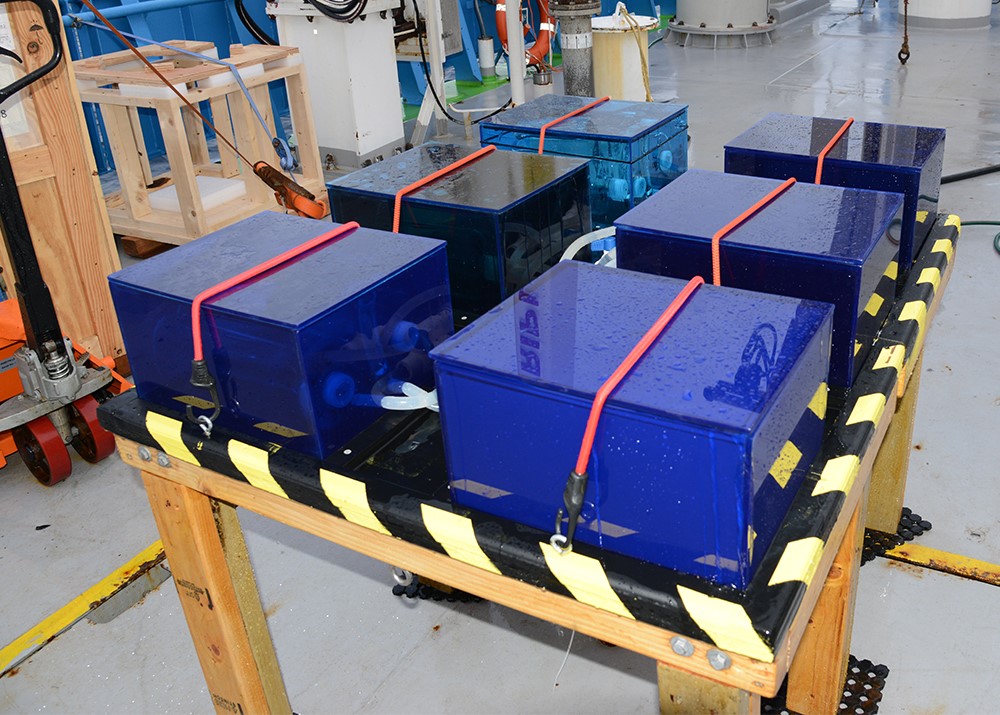 |
|
Simulating different light levels experienced at six different depths in the ocean, these seawater-cooled incubation tanks allow the calculation of phytoplankton growth and microzooplankton grazing rates. Photo: Micheline Jenner AM. |
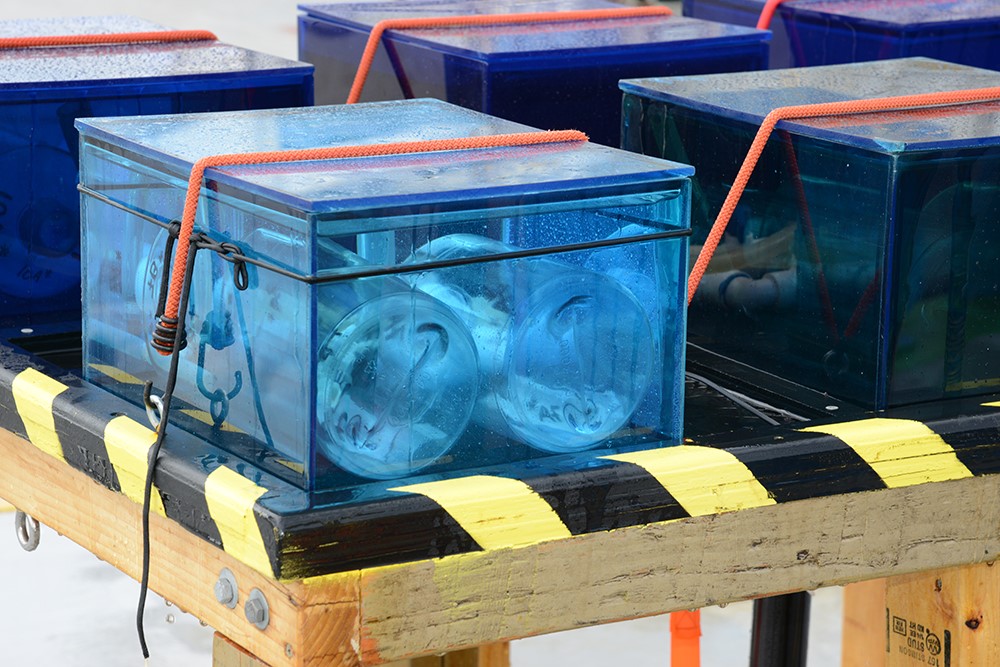 |
|
Each incubation box contains two bottles, one with the natural conditions of predators and prey and the other where the grazing conditions have been reduced or diluted. Photo: Micheline Jenner AM. |
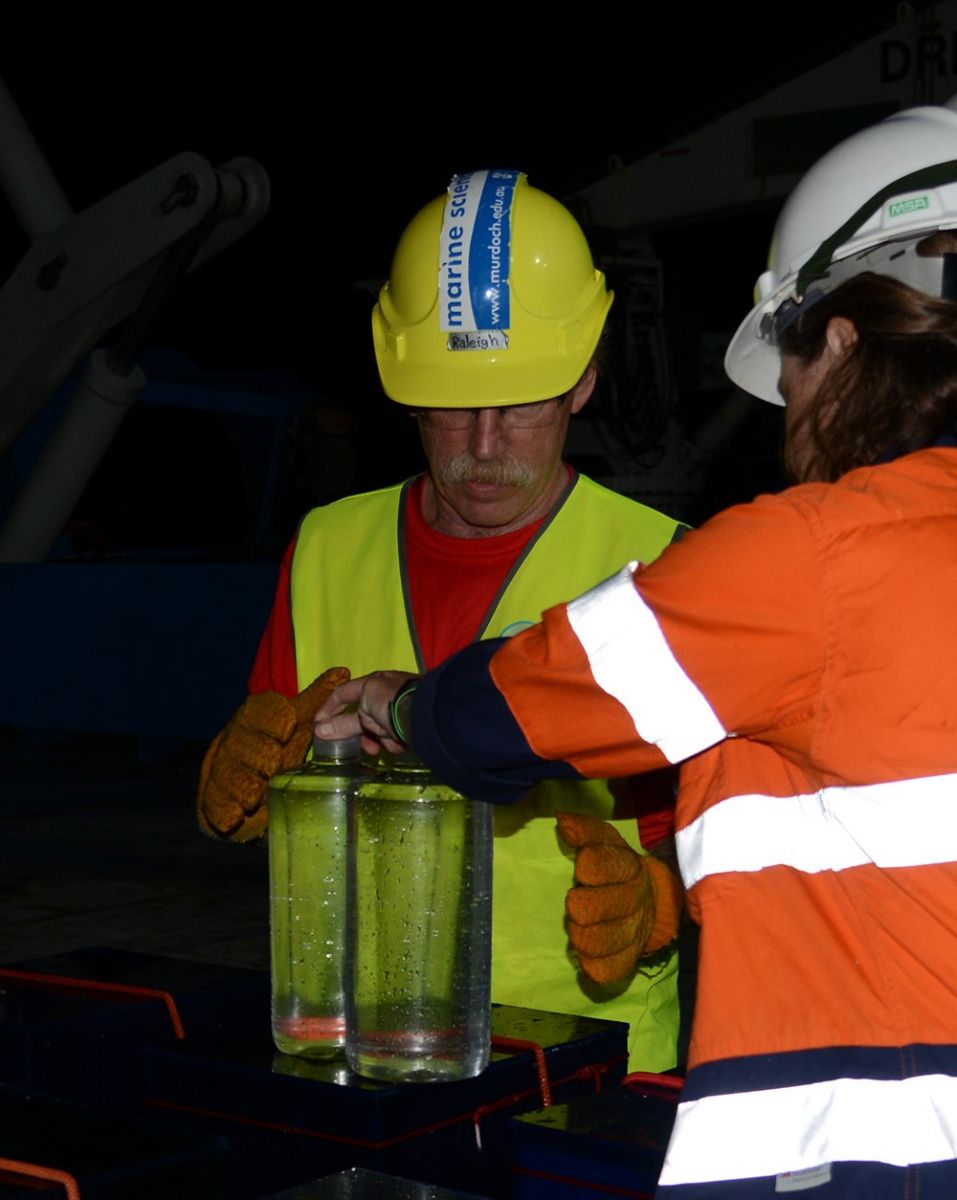 |
|
Prof Raleigh Hood (University of Maryland Center for Environmental Science) and Claire Davies (IMOS/CSIRO) tending to the dilution experiments on the aft deck of the RV Investigator. Here they are removing the bottles that have incubated for 24 hours. Photo: Micheline Jenner AM. |
Be sure to follow the daily posts of our One Ten East Logs from the IN2019_V03 aboard RV Investigator at https://iioe-2.incois.gov.in and www.wamsi.org.au .
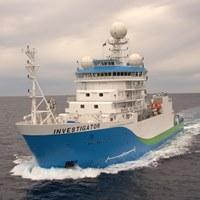
One Ten East Logs from the IIOE-2 voyage aboard RV Investigator will be posted on the WAMSI website during the month long voyage.
It’s getting warmer and we are loving it!
– Captain Micheline Jenner
Log from One Ten East
The RV Investigator is currently undertaking oceanographic research along the 110°E meridian off Western Australia as part of the second International Indian Ocean Expedition. The voyage is led by Professor Lynnath Beckley of Murdoch University and the research is supported by a grant of sea time on RV Investigator from the CSIRO Marine National Facility.
|
Date: May 30, 2019 |
Time: 1200 AWST |
|
Latitude: 20°S |
Longitude: 110°E |
|
Wind direction: E |
Wind speed: 5 knots |
|
Swell direction: SW 1 m |
Depth: 4133 m |
|
Air temperature: 26°C |
Sea temperature: 27°C |
|
Notes: A minke whale swam by the vessel today to confirm our sonobuoy detections! Another nice sunny day for the optics team! |
|
Bio-optics & Ocean Colour
By Prof David Antoine
Studies of marine bio-optics are being conducted from the RV Investigator during the 1100 East voyage.
Marine bio-optics is the scientific study of interactions between electromagnetic radiation (near ultraviolet to the visible and the near infrared) and particles or dissolved substances of biological origin in the water.
The interaction is described through absorption and scattering, which are referred to as inherent optical properties (IOPs).
These properties only depend on the composition of the medium, and not on the way it is illuminated (e.g. sun light on a clear day versus a cloudy day etc.).
By measuring these IOPs and the quantities that determine them (e.g., particle sizes, particle composition and pigments), one can derive bio-optical algorithms.
From the ship we will make in-situ measurements of the IOPs using a range of instruments as well as measuring particle sizes and composition.
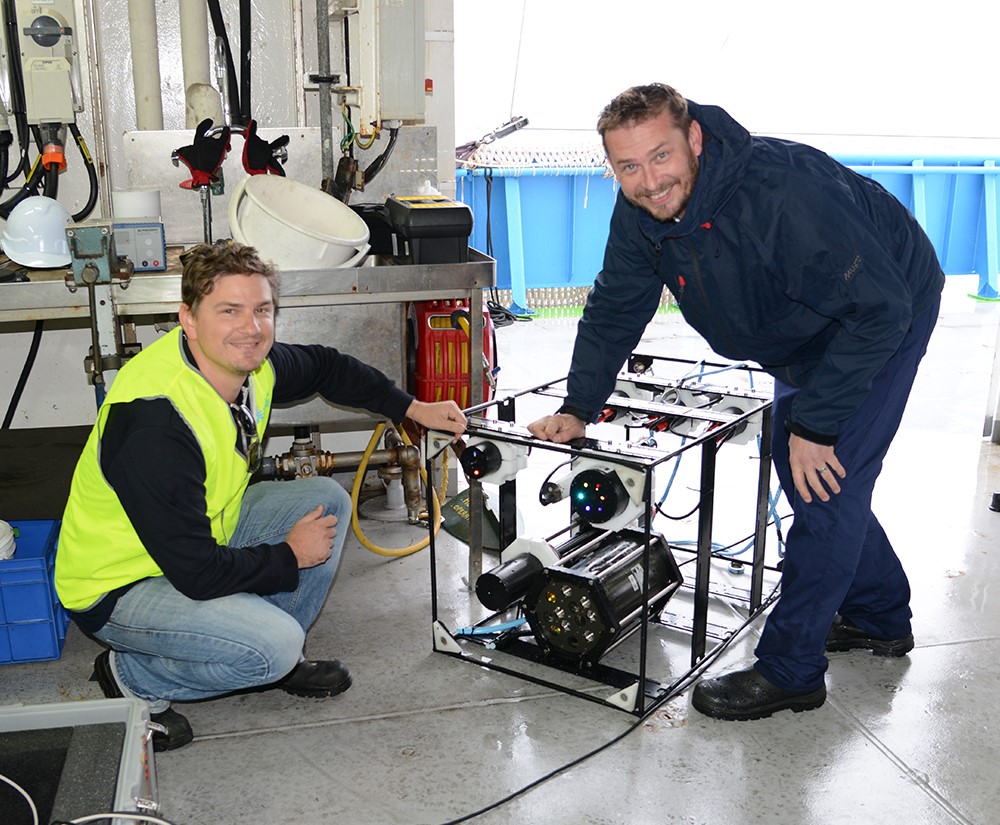 |
|
Dr Matthew Slivkoff (In situ Marine Optics) and Dr Wojciech Klonowski (In situ Marine Optics) indictating the components of their IOP (Inherent Optical Properties) package which they have just retrieved after collecting measurements in the south-east Indian Ocean. Photo: Micheline Jenner AM. |
Satellite ocean colour radiometry is the technique by which we quantify phytoplankton biomass from space.
Proxies of this biomass, such as chlorophyll concentrations can be derived from the satellite observations of the ocean.
The launch in 1978 of the first satellite carrying an ocean colour sensor, revolutionized the way oceanographers saw phytoplankton dynamics in the ocean.
The obvious advantage of this satellite technique is the provision of uninterrupted data sets over the world’s oceans which can be used in a wide range of science studies and applications.
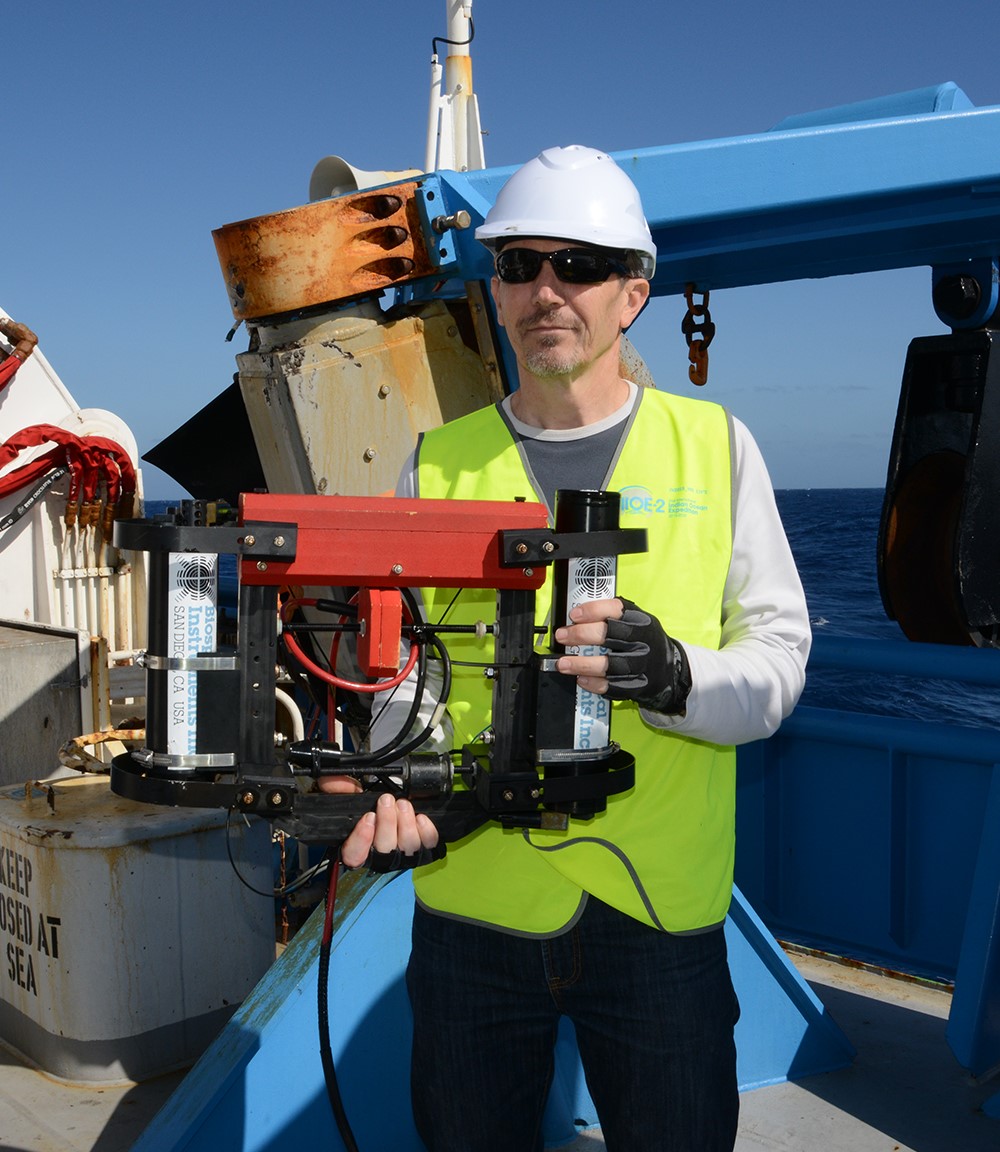 |
|
Prof David Antoine (Curtin University) holds a C-OPS profiling radiometer prior to deployment to measure the underwater light profile along the 110°East meridian. Photo: Micheline Jenner AM |
A major transition is currently underway from science-driven satellite missions of limited lifetime (5 to 10 years) to more operational satellite programmes designed to provide consistent and continuous observations over many decades.
The recently launched European Copernicus program is one such example.
During the 110°E voyage we are collecting data for validation of the monitoring products delivered by the Copernicus “Sentinel3/OLCI” mission.
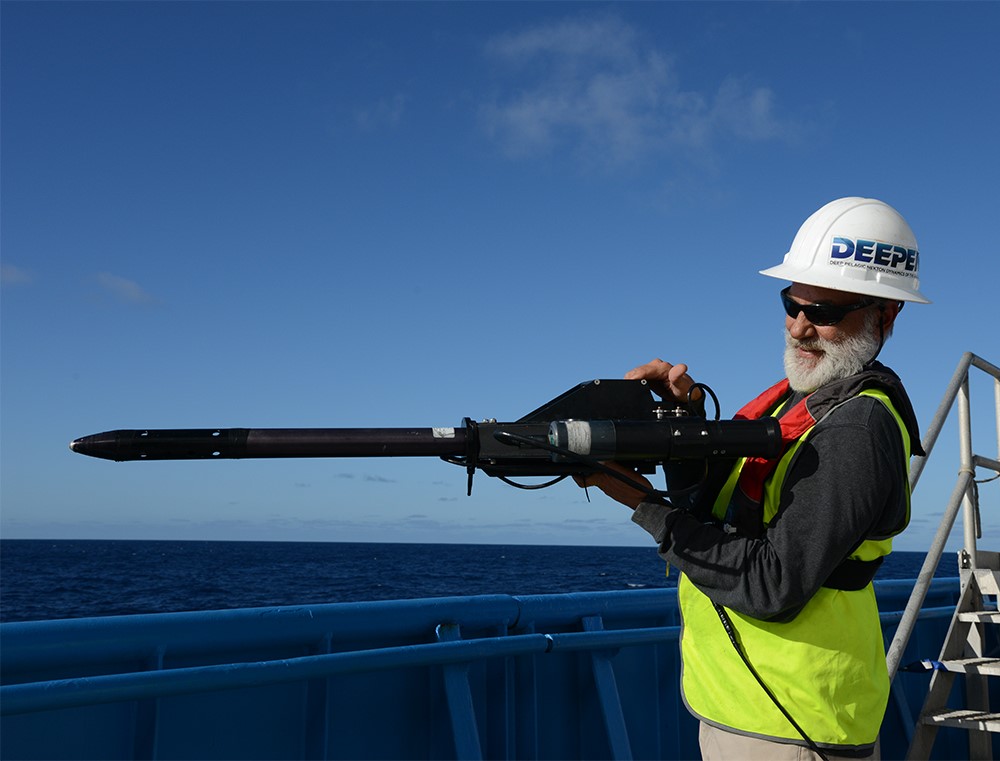 |
|
Charles Kovach (NOAA, USA) prepares to deploy a HyperPRO in-water profiling radiometer for establishing the underwater light profile in the tropical south-east Indian Ocean. Photo: Micheline Jenner AM. |
Be sure to follow the daily posts of our Log from One Ten East at https://iioe-2.incois.gov.in and www.wamsi.org.au
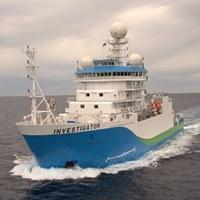
One Ten East Logs from the IIOE-2 voyage aboard RV Investigator will be posted on the WAMSI website during the month long voyage.
Curt and I were listening to an Antarctic minke whale for most of the morning and sure enough it came past the vessel. These are often curious whales, so we were optimistically expectant, that the loud caller might come by. A crew member on deck spied it and alerted us! Alas, we had had our heads in a spreadsheet to share our data. It was a fleeting but lovely visit, enough to confirm the caller we heard was indeed an Antarctic minke whale, yeah! – Captain Micheline Jenner
Log from One Ten East
The RV Investigator is currently undertaking oceanographic research along the 110°E meridian off Western Australia as part of the second International Indian Ocean Expedition. The voyage is led by Professor Lynnath Beckley of Murdoch University and the research is supported by a grant of sea time on RV Investigator from the CSIRO Marine National Facility.
|
Date: May 31, 2019 |
Time: 1200 AWST |
|
Latitude: 18.5°S |
Longitude: 110°E |
|
Wind direction: E |
Wind speed: 16 knots |
|
Swell direction: ESE 1.5 m |
Depth: 4981 m |
|
Air temperature: 26°C |
Sea temperature: 27°C |
|
Notes: Another tropical day with cumulus clouds and the deep blue sea. |
|
Cytometry in the Micro-CSI Lab
By Martina Doblin
The Microbial Cell Sorting and Imaging or Micro-CSI is a mobile laboratory belonging to the University of Technology Sydney (UTS) is being used on board RV Investigator. On this voyage, the Micro-CSI houses a state-of-the-art flow cytometer, which uses laser light to analyse living cells and sort them from other particles in seawater. Cells (ranging in size from 0.5 to 50 microns) can be sorted and counted based on characteristics such as their relative size, internal complexity and fluorescence properties, varying upon the identity and physiological status of each cell. Cells of the same species will share common attributes such as the number and type of cellular membranes, organelles and pigments and are therefore visualised as cells that cluster tightly in the graphical output.
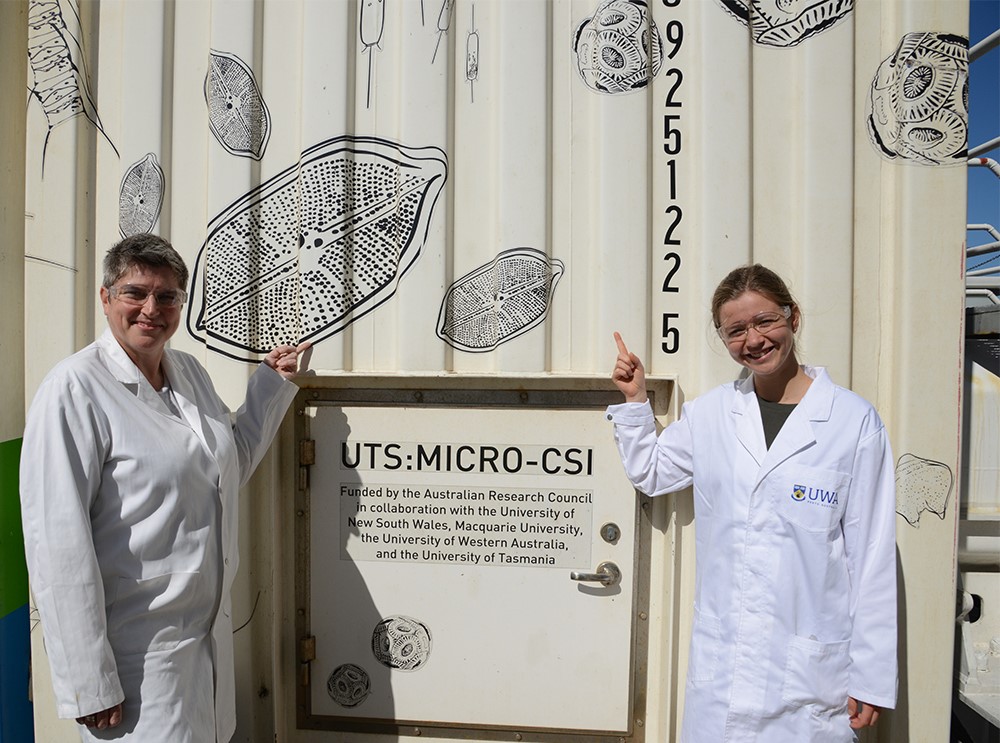 |
|
Peta Vine (PhD student University of Technology Sydney) at left and Camille Grimaldi (PhD student University of Western Australia) at right, stand outside the Micro-CSI mobile laboratory that has been loaded aboard the RV Investigator. Photo: Micheline Jenner AM. |
Using the flow cytometer, we are determining the distribution of phytoplankton populations collected at various locations along the 1100 East transect. We are also isolating cells capable of photosynthesis (those containing pigments such as chlorophyll) and preserving them for future on-shore analysis. This information will be used to help estimate the primary productivity of marine phytoplankton, which represents the potential for nutrients and energy to be transferred to upper levels of the food web.
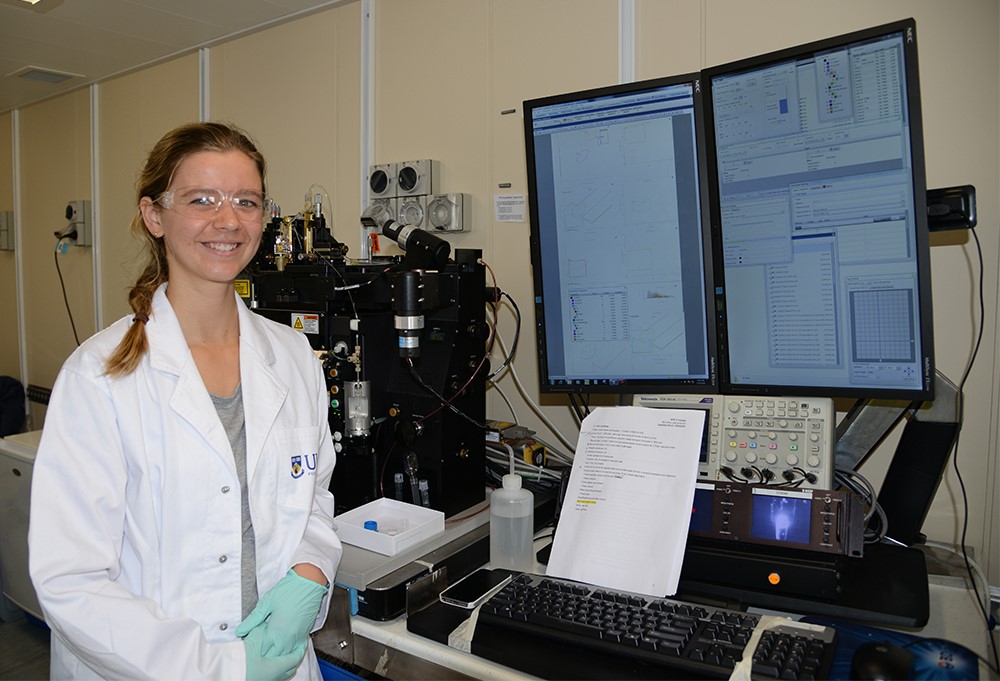 |
|
Inside the Micro-CSI laboratory, Camille Grimaldi (PhD student UWA) operates the state-of-the-art BD-Influx cell sorter. A water sample from the CTD is placed in a glass tube, and is analysed using lasers to provide detailed information regarding phytoplankton distribution and abundance along the 110°East meridian. Photo: Micheline Jenner AM. |
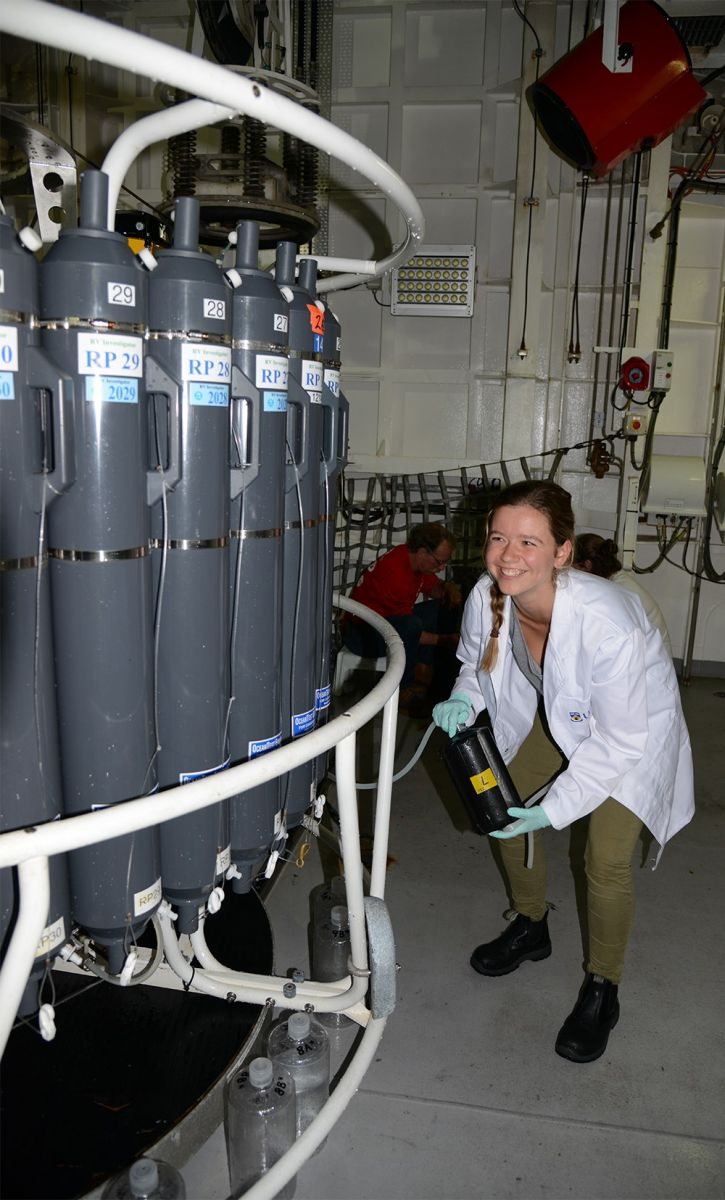 |
|
Camille Grimaldi (PhD student University of Western Australia) collects water from the CTD that is analysed using the flow-cytometer in the Micro-CSI laboratory. Photo: Micheline Jenner AM. |
Be sure to follow the daily posts of our One Ten East Logs from the IN2019_V03 aboard RV Investigator at https://iioe-2.incois.gov.in and www.wamsi.org.au.
Feature image: (L-R) Yawuru marine ranger Anthony Richardson, Minister for Science Hon. Dave Kelly MLA and DBCA Marine Park Coordinator Chris Nutt release the WAMSI Kimberley Marine Research Program Report in Broome
A new report into Australia’s remote Kimberley region could hold the key to answering global questions about how some ecosystems survive under extreme environmental conditions.
The report, “Strategic Integrated Marine Science for the Kimberley Region”, released today by the Minister for Science Hon. Dave Kelly MLA, is the culmination of five years of research by 200 scientists from 25 organisations working on 23 projects to understand the marine biodiversity and ecology at regional and local scales.
The information has been produced for the Department of Biodiversity, Conservation and Attractions (DBCA) to support decision making and operational activities for the region and the Greater Kimberly Marine Park network managed by DBCA jointly with Traditional Owners.
The program, managed by the Western Australian Marine Science Institution (WAMSI) collaboration of scientists from state, federal, industry and academic institutions, is one of the most comprehensive assessments of Australia’s North West.
WAMSI Science Program Leader Dr Kelly Waples (DBCA) said the report provides valuable information that can be used to predict and manage the likely changes in the future.
“How the Kimberley environment changes over time will be determined by the interaction of economic, ecological and social processes, climate change, human population dynamics and industry,” Dr Waples said. “By understanding how the environment has changed and the ecosystem has adapted over the past 100 years to what it is today, we can better predict the likely response to current and future pressures and how we might mitigate any impacts.”
This physically complex inshore environment supports a diverse range of habitats that include seagrasses and coral reefs, extensive intertidal mudflats and sponge-dominated filter-feeding communities with high levels of biological diversity. The region also supports large and iconic marine fauna including whales, dolphins, dugongs, turtles and estuarine crocodiles.
While aboriginal people have lived in the Kimberley for millennia and retain strong cultural connections to their saltwater country, this coastal and marine environment increasingly supports other activities such as tourism, commercial and recreational fishing, pearling, aquaculture and major port facilities associated with resource industries.
Despite the growth in activity, the research found that anthropogenic impacts remain low compared with other parts of the Western Australian coast and disturbance to much of the Kimberley marine environment is considered to be minor.
However, the study highlights the region is likely to be increasingly affected by a number of pressures including: climate change-related impacts such as coral bleaching; regional development and growth; and increased human access and use.
The $30 million Kimberley Marine Research Program was funded through major investment supported by $12 million from the Western Australian government co-invested by the WAMSI partners and supported by the Traditional Owners of the Kimberley.
Link to Minister for Science Hon. Dave Kelly MLA media statement